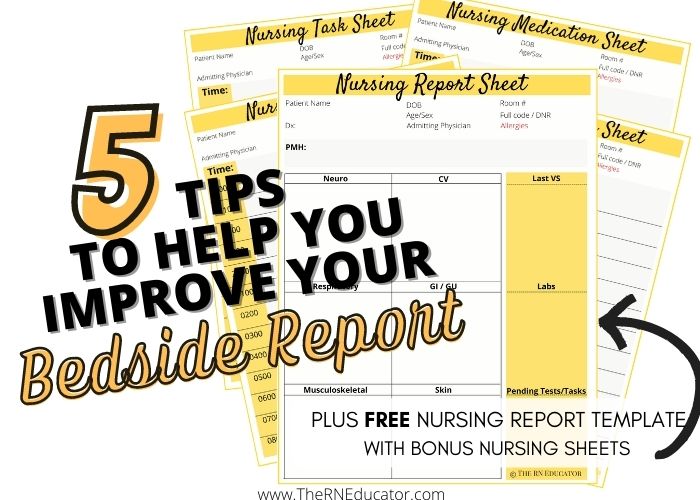5 Tips to Help Improve your Bedside Report

Hello, hello my nursing friends. As a new nurse one of the things I dreaded the most was the moment I had to give bedside report. I remember always being worried about who was going to be the oncoming nurse and was she/he going to chew me out if I didn’t have the right information readily available?
Granted- it is part of the learning process and with each time you give report you do get better and better but gosh! Was it necessary to be so ridiculously stressed about it? I know I’m not alone here and I want to tell you that it’s okay! It’s normal to feel that way and it will get better but until then I have come up with 5 of the BEST tips to follow when giving nursing bedside report. Follow these tips and you will always feel prepared and confident when giving and receiving report on your patient.
Before we jump in, I want to let you know I have also included a FREE nursing report template you can use while getting or giving bedside report. It’s a super easy way to keep everything organized and refer back to during your shift. I think you will find it very beneficial, especially when a doctor comes up to you and wants to know more about the prior shift (yes, they do that!). You’ll find the nursing report template at the end of this post. For now, let’s jump into it!
Tip 1: Always give beside report.
I cannot stress how beneficial bedside report actually is for you and your patient. Bedside report was created to prevent and limit miscommunication about your patient but to also maintain the patient informed and involved in their care.
You might be asking yourself “What is bedside report?” Well, bedside report is a comprehensive summary of your patients history, current medical information and progression/plan of care that is given from an off-going nurse to the oncoming nurse.
It is done at the bedside of the patient and is usually given when there is a change of shift or the patient is being transferred to another nurse or unit. Bedside report is important as sometimes certain information might be missed from one nurse to the other and a patient can actually remind a nurse about a pending task or even correct information that might have incorrectly obtained.
Many errors can be caught this way and actually assist in providing high-quality care to the patient leading to a quicker recovery. Remember, with any kind of report there should always be concern to maintain HIPPA. Always ensure your patient has total privacy when performing bedside report as sometimes the patient may have visitors or be on the phone.
Tip 2: Stick to a Head to Toe Method.
Sticking to a head to toe method not only keeps you organized but makes report so much easier to flow through. If you are giving bedside report you can literally look at the patient, start with Neuro and work your way down.
It is a very easy way to remember how to give report and serves as a road map for you and the oncoming nurse. It also helps both of you pinpoint any critical details about the patient. You can style this method of nursing report to include most important to least important information about each system.
The free nursing report template I have made for you all is organized in a head to toe systemic format to guide you with this.
Tip 3: Be Concise and Specific
Be clear when you are giving bedside report. Do not share information that is just left up to interpretation. It is important to be specific. An example of this could be: “this wound dressing needs to be changed twice a day.” That can leave the next nurse wondering “But…. when is twice a day?” Not only will this cause her to have to rummage through orders (which regardless- she will have to do to verify) but now she is stressed out making sure she finds this pertinent information, in a timely manner, on top of everything else she needs to do. Don’t do to someone what you wouldn’t want done to yourself.
A clear and specific way of sharing this information would be: “this wound dressing is changed every twelve hours. I last changed it at 1200 so it is due to be changed at midnight. Details about the dressing change are on the wound care order.” You can even go a step further and give a quick explanation about the dressing change. There is nothing wrong with helping out the oncoming nurse and sharing this information. In fact, it is encouraged and contributes to improving your patient outcomes.
Aside from this, making sure to provide clear and concise information also means sharing need to know information and staying away from information that is not relevant to your patients care or important to pass down.
Tip 4: Review Orders + Physician Notes before hand.
This tip will definitely help you prepare for your change of shift bedside report or change of nurse report. I cannot tell you how many times it has saved me when transferring my patient to a different unit or ending my shift. Reviewing your patients orders and most recent physician notes before hand is key.
The truth about nursing is, physician’s rarely get a chance to tell us about their assessment. They simply don’t have the time. They go to their computers, document, and put in their orders (which is usually how we know something changed). Reading their note before bedside report literally will tell you what their assessment was and their new plan of care (whether it is changed or unchanged). Trust me, you don’t want to miss this step.
Also, you want to make sure your orders are all up to date before you tell the oncoming nurse to do, for example “blood glucose every 4 hours”. Maybe the physician changed it to every 6 hours now. Get my drift?
Always be up to date on information you are relaying. Then, when you give report you can not only review any pending orders with the oncoming nurse but you can also share the latest updates from the physician and what that oncoming nurse should expect during their shift.
Pro tip: When reviewing orders always open up the details or notes section. Sometimes ordering physicians or head supervisors will write more information that can entirely change the order. (e.g., an order that reads “Obtain blood glucose q6hr”, when you click on details you might see a sliding scale of glucose levels and when to call the physician/ initiate insulin medication order.)
Tip 5: Stay organized.
Finally, last and most crucial tip is to stay organized. Make this a priority for your nursing report. Staying organized will avoid you to be all over the place and sound like a hot mess or dare I say it… unprepared! We know you aren’t unprepared but if you don’t have all your information organized then it will be hard to stay on track and pinpoint pertinent information.
Having an organized system will not only help keep you on track during report but will also allow you to find information very easily during your shift, especially when emergency or unexpected situations occur.
Here is a sample of the Nursing Report Templates I created for you guys. It is a complete freebie so feel free to download it. I have no doubt this will help you guys stay organized and on track when giving bedside report.

Download your free Nursing Report Sheet here or click on the image above.
’till next time,
The RN Educator
Share this:
Related Posts
What’s in a Pediatric Crash Cart? Nursing Students read NOW!
A pediatric crash cart is a mobile unit containing essential equipment and medications required for…
Share this:
How to Become a Confident Nurse
If you are anything like me, and let’s face it (like every nurse…



